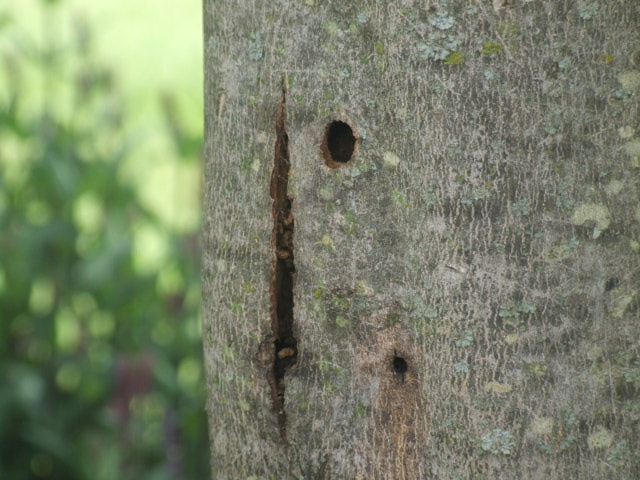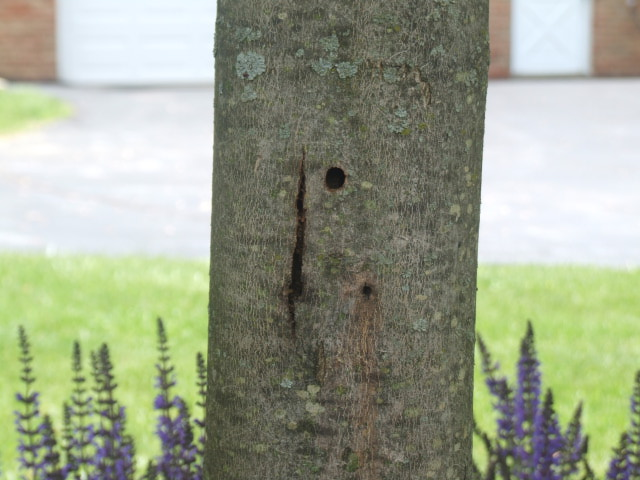Question Autumn Blaze Closeup
Autumn Blaze Closeup
 Autum Blaze Trunk Diea
Autum Blaze Trunk Diea
QUESTION: Hello Dr Vann,
I planted two Autumn Blaze maples that were 3 inch caliber and about 15 feet high at the same time about 4 years ago. They are planted on the side of a hill parallel to my paved driveway and about 15 feet off the edge of the drive. I keep them watered every summer and use Jobes tree spikes on them annually except in their first year. For the past 3 years I also have been using Bayer's Tree and Shurb liquid on them to build up their immune system.
The tree at the top of the hill is noticeably thicker in the trunk and a bigger head than the one in the attached photos that I planted 30 feet down the hill from the healthy tree. They were both very healthy when planted in the fall of 2010.
About 40 inches from the bottom of the tree there are two holes in the trunk and a split to the left of both holes. When lightly pressing in on the bark between the two holes and to the right of the split, the bark is soft like there is nothing behind the bark.
A couple of weeks ago I stuck a stick in the hole to probe how much wood is missing and how far the missing wood goes. When I retracted the very small stick, a stink bug came out!
I planted both of these trees to provide late evening shade on my brick home's western wall. I don't want to lose this tree. What do you suggest I do?
Thank you for your help!
Mike
ANSWER: Mike:
The stink bug that you found was probably not the primary issue here, but probably just a nice cozy place to hide. The bark split probably came first followed by an insect or two. Bark splits on thin barked trees such as maple are often caused by sun scald/freeze injury. Young trees tend to be most vulnerable. The split can be an avenue for insect and/or disease entry. Unfortunately there is no magic bullet here. Tree selection is useful to resist this injury. Sometimes tree wraps may help when kept on during the winter. For this particular tree, good fertilization/water to promote vigor is best. The tree may be able to "wall off" the distressed area if it is growing vigorously, however it will be a weak area in the overall structure for sometime.
Regards
Steve
---------- FOLLOW-UP ----------
QUESTION: Hi Steve,
Thank you for your assistance. May I share a follow-up thought and ask two more questions?
I have noticed my Autumn Blaze Maple trees getting cracks as along as 3 to 4 feet in length on the southwestern sides of the trees. They always heal over in one season. The mate to the tree in the photos had a 4 foot long crack two years ago that was pretty wide. This crack completely healed over in two seasons.
Between the crack on the left and the two holes on the right, the wood behind the bark appears to be gone like there is a hollow space behind the bark. This hollow space measures 2 inches high by inch and a half wide.
Additionally, the wood in the tree all along the crack in the photos of this tree is soft and crumbly almost like dust/dirt piled up in the corner of a garage. Over the past three years when the bark split on the other Autumn Blaze maples I planted, the wood always stayed hard under the bark while the splits healed.
I am concerned about that soft material being like a sponge that will absorb water and promote further decay. Should I remove the bark in the area between the crack and the two holes with a knife to expose the area to the air to air it out?
How do I stop insects from making a home in this area using the two holes or crack as an entry point?
Thank you very much Steve!
Appreciatively,
Mike
AnswerMike:
There indeed may be some active decay in this area. If you elect to remove the wood, you may not be able to get it all out. Be careful about the removal if you decide to, you don't want to do more damage by "gouging" into the healthy stuff. It is difficult to determine how deep this area is into the tree. This will weaken the overall structure of the stem. Replacement may be an option. If the tree is growing vigorously, some healing will occur, but there will always be a weak area there. This may cause breakage at some point- especially during high winds or winter precipitation accumulations.
Steve







